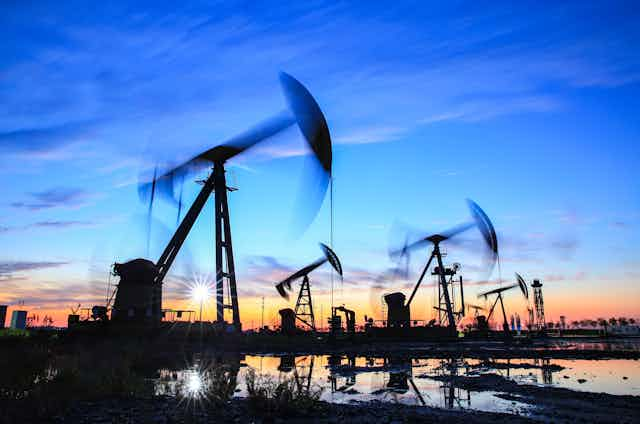It was a rare bit of good news on climate. The International Energy Agency this week released its latest net zero roadmap, showing it was still just possible to hold global heating to 1.5°C.
In the last two years, we’ve seen major global investment in clean energy, spurred on by energy independence concerns raised by the war in Ukraine, as well as intensifying extreme weather.
Even so, it’s unlikely to actually keep us under 1.5°C, the globally agreed target to avoid the worst impacts of climate change.
Why? Because emissions are still rising – even as many countries make their energy grids greener.
Why is it so hard?
In part, because we’ve left our run very late. The Intergovernmental Panel on Climate Change released its first assessment in 1990. Since then, the world has emitted one trillion tonnes of carbon dioxide, which is two-thirds of the carbon budget. That is, the amount of permissible emissions that would feasibly allow us to limit global warming to 1.5°C above the pre-industrial temperature.
At the beginning of this year, the world had just 380 billion tonnes of carbon dioxide left in the carbon budget. Global emissions have been about 40 billion tonnes a year over the past few years with no sign of decline. At that rate, we’ll hit 1.5°C in about nine years, and 2°C in 30 years.
Read more: Renewables are cheaper than ever yet fossil fuel use is still growing – here’s why
We are not moving fast enough, on enough fronts, to wean ourselves off fossil fuels.
For instance, even though the use of electric vehicles is growing fast, it’s off a low base. The world still has an estimated 1.4 billion internal combustion engine cars, which run on petrol, diesel or gas.
Emissions from all forms of transport are increasing. Fossil gas use is surging. Coal use was thought to have peaked in 2013. But it’s back at even higher levels over the past two years, as nations scramble to shore up energy supplies due to the war in Ukraine.
Clean alternatives haven’t yet replaced fossil fuels at sufficient scale. It doesn’t matter how many solar panels are installed unless they also substitute the power that fossil fuels provide. And on a global scale, that’s not happening quickly enough to prevent us hitting 1.5°C.

But the good news is we’re finally seeing something that seemed all but impossible just 10 years ago – nation after nation finally getting serious on climate change.
Renewables are so cheap they’re getting built because they make money – at the expense of old fossil fuel plants. Electric vehicles are here, and will make life better, from cutting running costs to radically improving air quality in our cities. Many nations will achieve energy independence.
We are making rapid progress in greening the electric grid, with China building even more renewables than its government targets. On the streets of Shanghai and Oslo, electric vehicles are a common sight.
These trends need to spread worldwide, and fast.
Read more: We just blew past 1.5 degrees. Game over on climate? Not yet
Economic sectors that produce large volumes of emissions, such as concrete and steel making, are difficult to decarbonise and will take longer. Likewise for the aviation and food system sectors, where emissions keep rising.
Renewables, after all, are a means to an end. The goal is to rapidly reduce the use of fossil fuels, with any unavoidable emissions captured and permanently sequestered.
Until now, the very best we’ve done is to meet the growth in global demand for energy with non-fossil fuel sources – not to actually cut emissions. To actually slash emissions means transformational change.
Why the positive forecast?
Our best climate projections, the rate we’re using our remaining carbon budget, and current climate policies in place all consistently lead us to temperatures well past 1.5°C by the end of the century.
So why is the International Energy Agency still floating the possibility of stabilising the climate at 1.5°C?
If you read the report, it becomes clear. Achieving net zero at this late stage will mean overshooting 1.5°C – and then using trees and negative emissions technologies at a very large scale to bring us back to that level.
This will take the creation of a whole new industry of atmospheric greenhouse gas removal and decades of effort.
So even as the world accelerates climate action, the claim that we can avoid climate change from reaching and passing 1.5°C is out of reach.
What does this mean?
If humanity blows past the target of 1.5°C and keeps warming the planet, it doesn’t mean we just give up. Every decimal of a degree avoided matters a lot.
We’re only at 1.2°C now, and extreme weather, fire activity and other damage from climate change is coming thick and fast.

But there are clear risks in relying too much on the potential of removing large quantities of greenhouse gases from the atmosphere while also bringing down emissions as close to zero as possible.
Overshooting 1.5°C has another important implication. For years, climate action – cutting emissions – has been at the forefront of global efforts. But we have been too slow. Now we have to adapt to the rapidly evolving climate, with new policies, investment and preparedness.
This is not a story of unavoidable catastrophe. Climate scientists, on the whole, are optimists. All the work being done means we’re finally seeing positive change. But the numbers don’t lie. We must get those emissions down.

